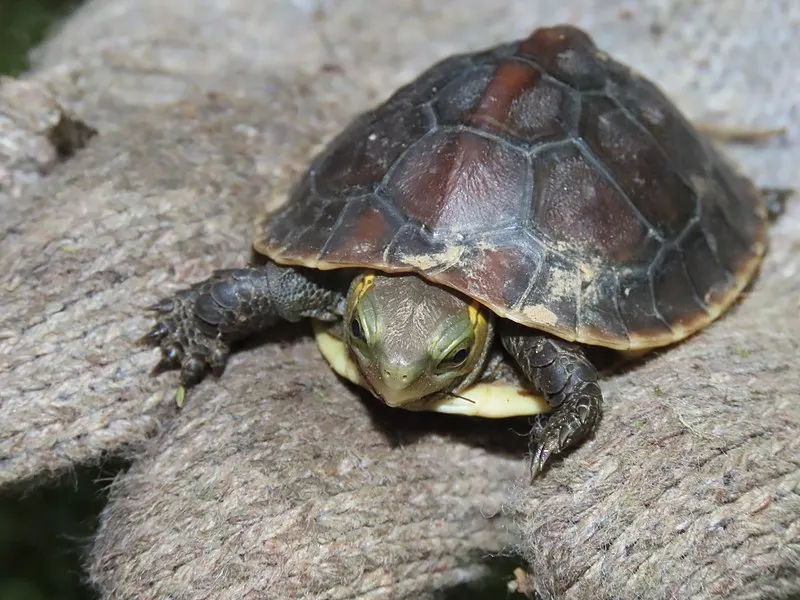What types of turtles are there in the world? Let’s take this exploratory journey together if you want to know about this and more about turtles.
Turtles are unique animals and cousins to the tortoise. While tortoises live on the land, the turtles’ habitat is in the water. These reptiles evolved millions of years ago. They are among the oldest reptiles in the world existing before snakes and crocodiles.
Like other reptiles, you will come across different types of turtles on every continent except Antarctica. In fact, scientific records show that there are over 350 species of turtles.
Each of these species has its unique traits and characteristics. However, some of them have since faced extinction due to poaching, harvesting of their eggs, and climate change. For this reason, many countries classify them under the endangered species category. This aspect gives them legal protection.
Currently, there are around 6.5 million turtles on the planet. Most are wild, while some are kept as pets, and at government conservancies. While you will find many species of turtles as noted above, which are the main types?
Different Types of Turtles
When you visit different places in the world, you are likely to see different types of turtles. These turtles differ in their body characteristics. Some are good to keep as pets, while others reside in freshwater or salty water lakes and seas.
Sea Turtles
1. Leatherback Turtle
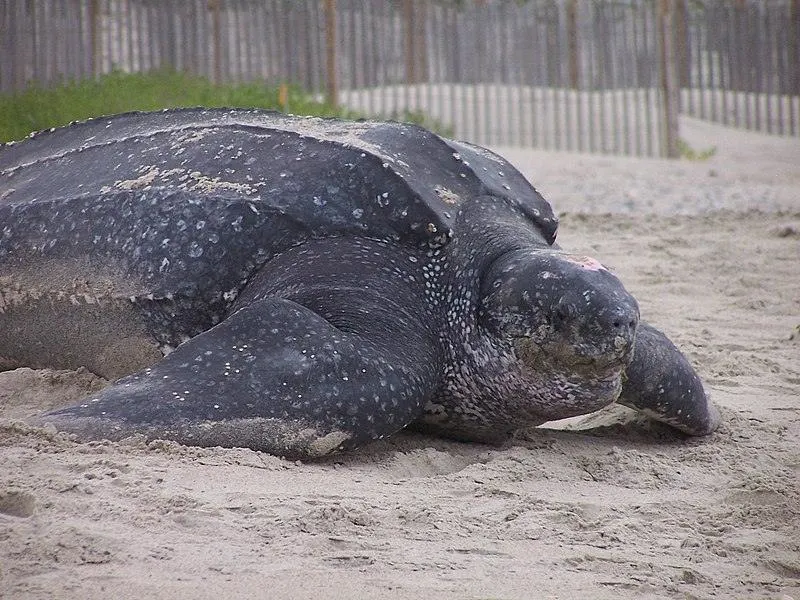
The leatherback turtle is the giant of all aquatic turtles. This aquatic species has a length of up to 6 feet, making it the largest turtle on the planet. Also, it travels the farthest and swims deepest, reaching up to a depth of over 3000 feet.
An adult Leatherback turtle weighs between 300 and 640 kgs. This turtle differs from other types of turtles mainly by its looks. Just a look at its turtle shell is enough to help you identify this animal.
A leatherback has leathery unique shells with a thin layer of tough and rubber-like skin. The turtle shell has thousands of bony plates, which make it pretty strong. Also, it is the only turtle in the sea that does not have a hard shell.
The Leatherback turtle carapace has seven distinct ridges spread across its body length. This carapace is flexible and does not have scales.
While most leatherback turtles will have a grey carapace, others will have a black carapace with white or pale spots. Also, there are turtles from this group that are pure black or whitish.
This makes it easier to differentiate them from other types of turtles in the sea.
Considering their feeding aspect, Leatherback turtles feed on jellyfish and other jelly-like organisms. They cannot feed on hard-bodied organisms due to their delicate jaws.
And when it comes to reproduction, Leatherback reproduces through laying eggs. The turtle can lay up to 80 fertilized eggs. The female turtle has a specific nesting beach but can change from time to time.
You will find them in Alaska all the way to South Africa.
2. Loggerhead Turtle
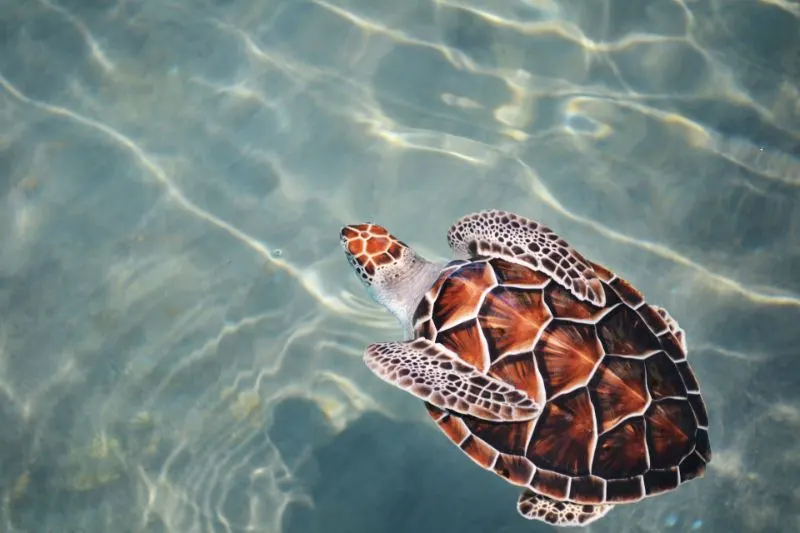
Next on our list of turtles is the Loggerhead. These types of turtles get their name from having a large or log-like head. Unlike the Leatherbacks, these turtles are known to have pretty strong jaws, and also lack ridges on their carapace.
Instead, they have scales or scutes, which are large and non-overlapping. The carapace is bony and with a heart-like shape, and adult turtles have a reddish-brown carapace with yellowish-brown plastron.
The Loggerheads can grow up to a length of up to 3.5 feet and weigh between 70 and 170 kilograms. Unlike leatherbacks, they feed on shellfish, crabs, and other small sea invertebrates. The strong jaws are effective in crushing hard shells.
Loggerheads lay eggs in 3 to 6 nests per season. Each nest can consist of between 100 and 126 eggs that incubate for 60 days.
Considering their habitat, Loggerheads live in the coastal bay and shallow waters. You will find them mostly in the Atlantic, Pacific, and Indian oceans. They prefer tropical temperatures and waters and can find them in any ocean around the tropical region.
3. Green Turtle
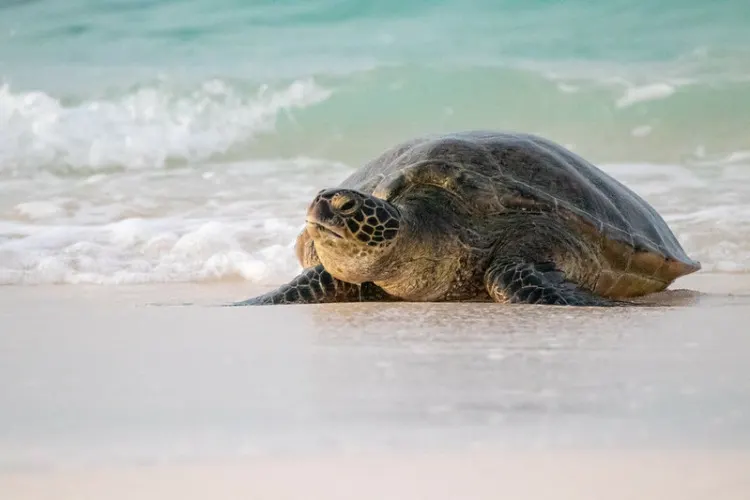
This turtle gets its name from the color of the green fats found under its shell. Green turtles feature a carapace with zero ridges. This part has four lateral scales that are large and non-overlapping.
Its prefrontal single pair of scales is what makes it distinctive from other turtles.
The turtle has an oval-like body which is flatter than other turtles in this family. This turtle has two sub-groups; the black sea turtles and the Pacific green turtles.
The green turtles’ carapace color ranges from pale grey to green. You will come along turtles in this group with brown, brilliant yellow, and green tones featuring radiating stripes. Their plastron also varies depending on the turtles’ habitat.
Green turtles are ocean dwellers. The Pacific green turtle features bluish, green, and dark grey plastron, while the Atlantic has dirty white, white, or yellowish ones. Their hatchlings are black or dark brown with a white bottom.
In terms of diet, adult green turtles feed on plants. While young, these turtles feed on insects, worms, algae, and grass. They can grow up to a length of 4 feet and weigh between 110 and 190 kg.
Green turtles nest after every 2 years. They can nest 3 to 5 times per season and lay up to 115 eggs per nest. Since they feed on plants, they love to stay on the bays and are unlikely to live in the open seas.
Notably, green fat under this species’ shell is a high sort for the element. People use it to make delicious green turtle soup, which makes them an endangered species.
See related: Malayan Tiger
Types of Small Turtles
4. Kemp’s Ridley Sea Turtle
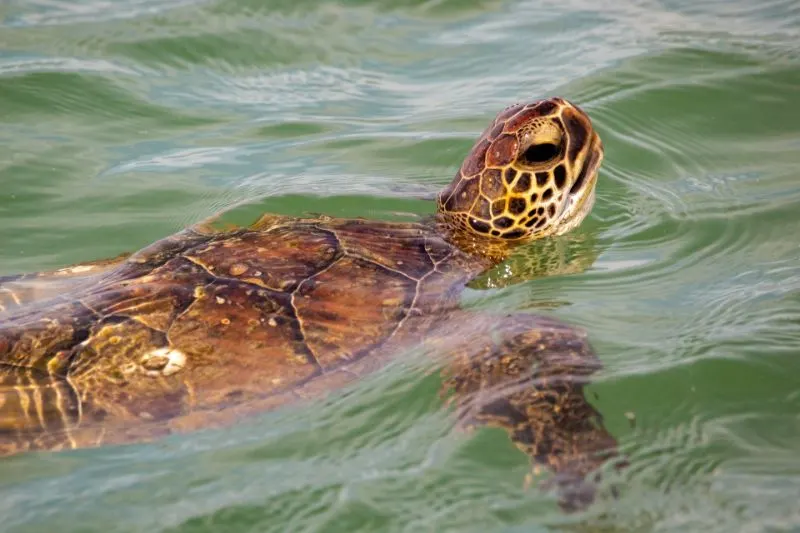
Kemp’s Ridley is one of the famous types of sea turtle species. These turtles have a length of 2 feet and weigh between 32 and 50 kgs. They have a moderate head and are triangular.
Like the green turtle, their carapace has no ridges. Instead, it is large with non-overlapping scales divided into 5 rounded laterals. The adult carapace color is dark grey-green, featuring white or yellowish plastron, while their hatchlings have a jet black one.
These turtles have a strong and powerful jaw which enables them to feed on clams, crabs, mussels, jellyfish, fish, sea urchins, and squid. The common habitat of the Kemp’s Ridley turtle is on the Caribbean shores in Northern Mexico.
Also, you will find a large number of these turtles in Texas, USA. These bay areas have sand or are muddy, offering the best habitat for this species.
Kemp’s Ridley turtles have the most often nesting intervals. The nesting varies from one to three years. Unlike other turtles, these small turtles have a mass nesting approach called arribadas (meaning arrivals in English).
The turtle can lay up to 110 eggs per nest. Their eggs have an incubation of 55 days.
5. Hawksbill Turtle
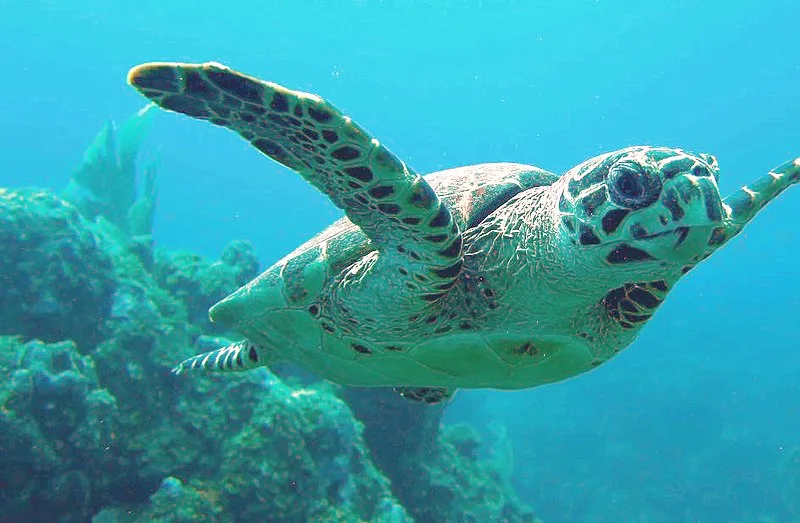
Hawksbill is another turtle that fits in the sea turtle group. Named after their head and hawk-like pointed beak, this painted turtle species have a beautiful shell that attracts traffickers. Their head features two pairs of scales.
The Hawksbill turtles feature an elliptical-shaped carapace with four overlapping lateral scales. You will notice them by the color of their bright carapaces, which are yellow, orange, or brown.
These turtles have a small length of between 2.5 and 3 feet. They weigh between 46 and 70 kilograms.
With sharp beaks, these turtles feed on coral reefs, sponges, shrimp, and squid. They also eat jellyfish and other small fishes.
On reproduction, the Hawksbill turtles have a nesting interval of 2 to 4 years. They can lay eggs 3 to 6 times during the nesting season, with each nest having an average of 160 eggs. The eggs take 60 days to hatch.
Hawksbills are rocky sea residents. As they feed on animals that reside on the rocks, their habitat is on the rocky areas, coast reefs, and lagoons. So, you can come across these turtles on all tropical waters be it the Pacific, Atlantic, or Indian oceans.
Like many sea turtles, the Hawksbills face the threat of harvesting due to their expensive shell.
Their shell is popular for making jewelry, decorative items, and hair ornaments.
See related: West African Manatee
7. Olive Ridley Sea Turtle
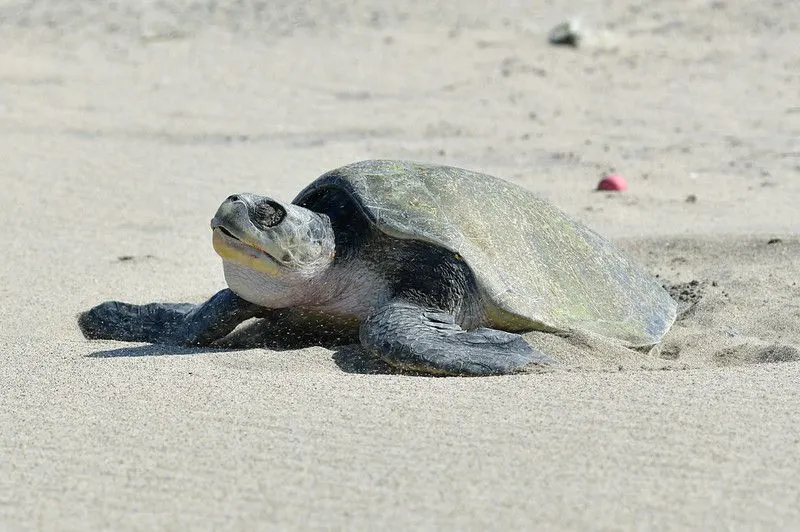
These small turtles get their name from their olive-colored carapace. They have a small head and 6 lateral scales on their carapace.
Their length range between 2 and 2.5 feet with a weight of up to 45 kgs. Unlike their counterparts, these turtles are omnivores meaning they feed on both sea insects or invertebrates and plants.
When the nesting season kicks in, a mass of thousands of female turtles goes to the beaches to lay eggs. So, they follow the behavior of Kemp’s Ridley turtles. The Olive Ridley turtles have annual nesting with two seasons.
They lay up to 110 eggs per nest, and these eggs take between 52 and 58 days to incubate and hatch. Their nesting grounds are along the coasts of Central America and India.
Marsh Turtles and Pond Turtles
8. European Pond Turtle
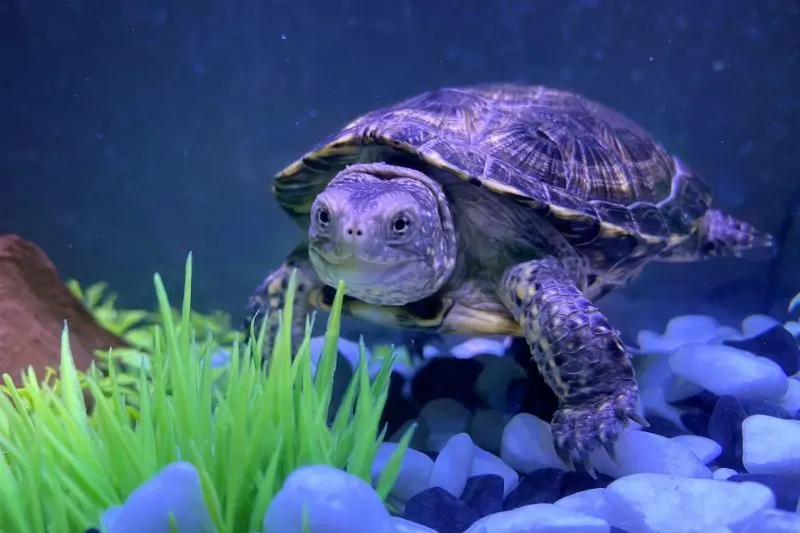
European Pond Turtles have long lives and are native to the Western Palearctic. Their carapace is dark brown to black with a sprinkling of green.
Spots of yellow can be seen on the body, including the head and legs. This plastron has a distinct yellow tint. This turtle species evolved to have a longer tail and webbed feet.
Despite their name, European pond turtles are not strictly aquatic. They can travel up to 4 kilometers away from their regular habitat on land.
The European pond turtle is a sociable creature. They often bask for long periods of time on stones, logs, or banks during the day. These turtles stay submerged for up to 8 hours at a time. Pond turtles burrow deep under the muck over the winter months and emerge in the late spring.
The diet of a European pond turtle consists of both plant and animal matter, making it both a carnivore (piscivore) and a herbivore. They eat water plants and animals such as fish, snails, frogs, salamanders, crabs, and insects.
European pond turtles are distributed in southern and central Europe, West Asia, and North Africa. They thrive in marsh habitats that are also close to forested upland areas, and they often migrate between the two.
9. Western Pond Turtle
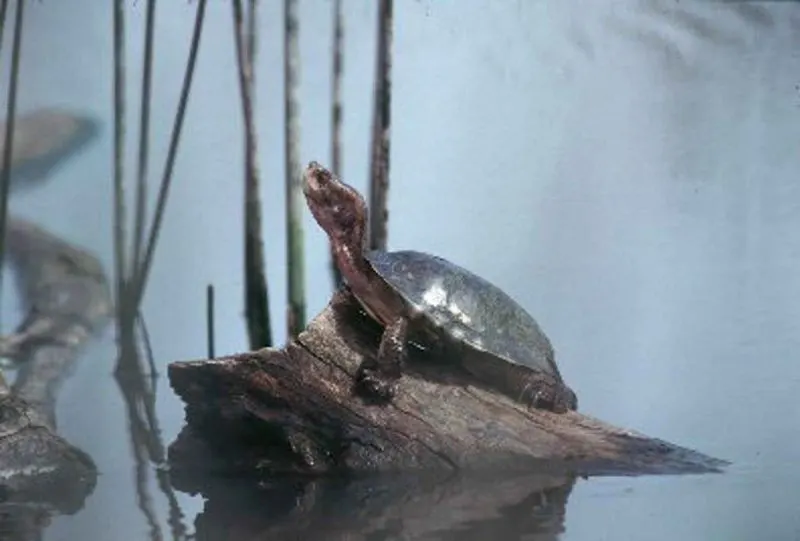
Medium-sized Western Pond Turtles are endemic to the Pacific coast of North America and Mexico.
Commonly, they have a brownish or olive tone with reticulations or streaks of a darker hue. The plastron is generally yellowish with occasional dark splotches in the scutes’ centers. The carapace is flat and broad, with its greatest width located posterior to its midline. Note that there are no keel and serrations in mature specimens. The adult Western Pond Turtle is sexually dimorphic, with the males having a lighter or pale yellow neck.
The Western Pond Turtle is a semiaquatic, solitary reptile. Although they spend most of their life in the water, they need land to breed on. These turtles congregate to bask on areas with many emergent logs or boulders.
This species of pond turtle is active during the day and typically does its hunting in the evening. They are extremely wary of humans and will quickly flee to the water if they perceive danger. They swiftly pull their legs and heads within their shell for safety.
To put it simply, Western Pond Turtles eat anything they can. Insects, crayfish, and other aquatic invertebrates make up a large part of the diet. There is some carrion consumption and occasional consumption of fish, tadpoles, and frogs. Filamentous algae, lily pads, tule, and cattail roots are all good plant meals. The start of their plant-based diet occurs during the third year.
This species inhabits the coastal regions of the western United States and Mexico, from the western tip of Washington state to the northern tip of Baja California. Their habitats include wetlands, running water, lakes, and ponds.
10. Common Box Turtle
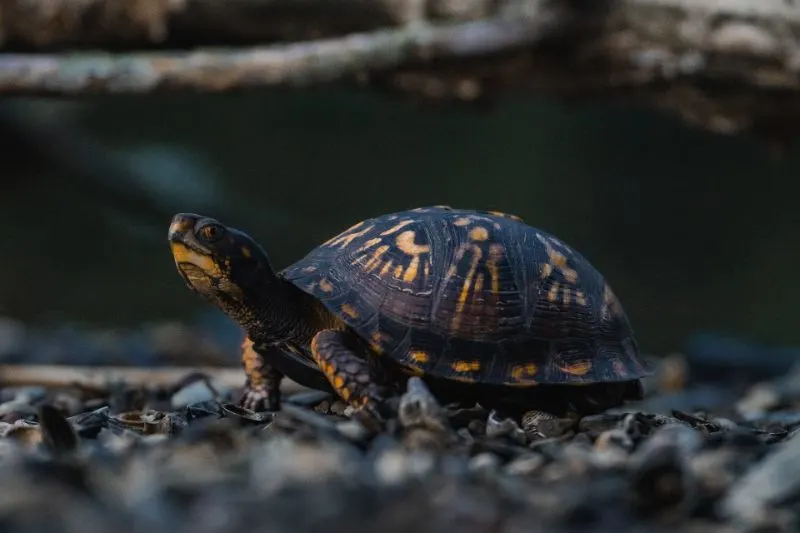
The upper part of a Common Box Turtle’s shell is highly domed. As is typical of box turtles, their shells may open and close on hinges. They have a curved beak that points downward. It’s possible for them to reach a length of 8 inches. A common box turtle’s shell may be a dark hue like brown with contrasting brighter spots like yellow or orange.
Common Box Turtles can survive in arid environments on rare occasions, but they are most at home in wet, wooded settings with plenty of brush. Although they are not aquatic, they have been known to spend extended periods of time in mud or shallow water.
Sometimes, the life expectancy of a Common Box Turtle might reach a remarkable 100 years. To live to such a ripe old age is seen as less likely when one is held captive.
The Box Turtle is an omnivore. Their preferred meat source is insects of various sizes, including slugs, grubs, earthworms, and so on. In terms of plant matter, they eat things like berries, flowers, mushrooms, specific types of grass, and fruit.
The majority of sightings of this turtle are recorded from the eastern seaboard. They are most at home in gently damp, woodland environments. If the conditions are ideal, you can find them as far north as Maine and as far south as Texas.
11. Ornate Box Turtle
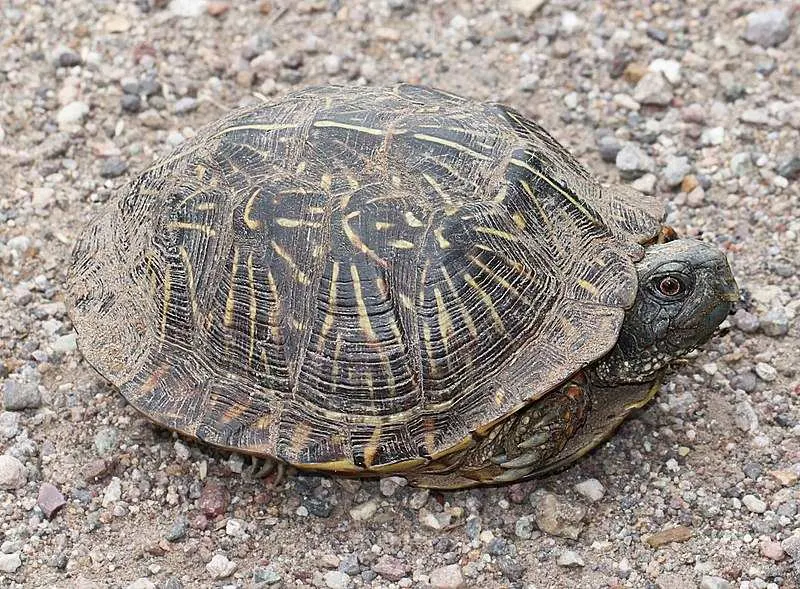
This little, brightly colored turtle has a hinged bottom shell and a domed upper shell. The top of the shell is usually flat or smooth, without a ridge; it is typically brown, and there are many yellow lines that radiate from the center of each plate.
There are brown patches and blotches all over the lower shell, with the occasional yellow spot. Both the head and the limbs are dark or black, with yellow splotches and dots. As a rule, each back foot has four toes.
Ornate box turtles get the vast majority of their nutrition from insects like grasshoppers, beetles, and caterpillars; but, they do consume a little amount of plant material like berries and delicate shoots.
This species can be found throughout the open woodlands, glades, and pastures of Missouri, as well as the state’s native prairies.
See Related: Sea Turtle Conservancy
12. Three-Toed Box Turtle
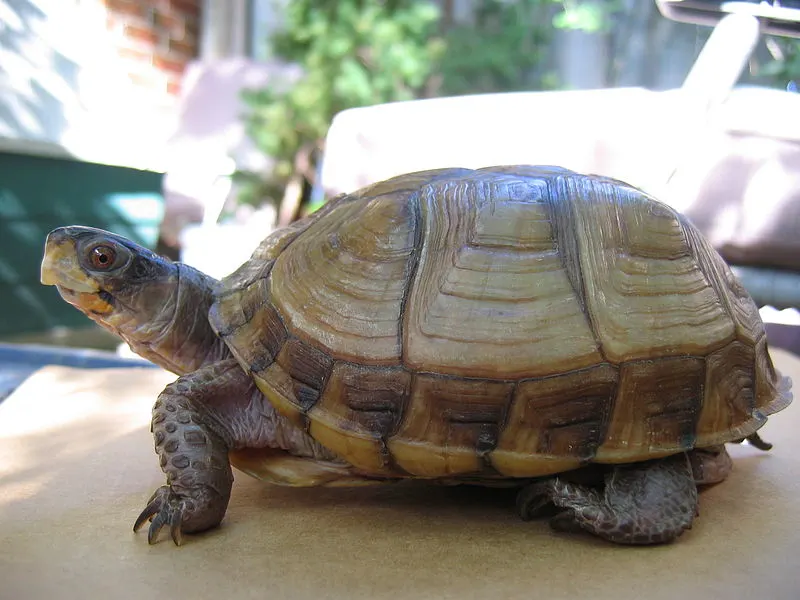
The Three-Toed Box Turtle is a subspecies of the Eastern Box Turtle. Although the name “three-toed” refers to the number of toes on the hind feet, some researchers have found evidence of four-toed box turtles. Nonetheless, there is conjecture that the four-toed ones are hybrids of Eastern Box Turtles and Three-Toed Box Turtles.
The average adult Three-Toed Box Turtle measures between 13 to 18 centimeters in length, and its shell is dome-shaped. Its upper shell, or carapace, is more dorsally located than that of any other subspecies.
Adult turtles typically have little coloring on their dorsal or limb surfaces, though they may have dark blotches. These regions typically have a consistent olive green or tan appearance. Each huge scute may occasionally feature a faint yellow dot or line in its center.
Spots of yellow, red, or orange are common on the male’s head and throat. The plastron, or bottom shell, of several of these species is a straw yellow tint and has significantly fewer dark markings than the plastrons of the other subspecies.
Omnivorous in nature, the Three-toed box turtle’s diet shifts depending on the time of year and the resources at its disposal. Their diet typically consists of earthworms, insects, snails, slugs, berries, mushrooms, and various types of greenery. Sightings of them consuming quail eggs have been made. All box turtles are more interested in eating other animals than plants.
Within its native range, the Three-toed Box Turtle can be found all the way from eastern Texas to the northern tip of Florida’s Panhandle. Missouri and Kansas mark its northernmost range, while Louisiana marks its southernmost.
13. Painted Turtle
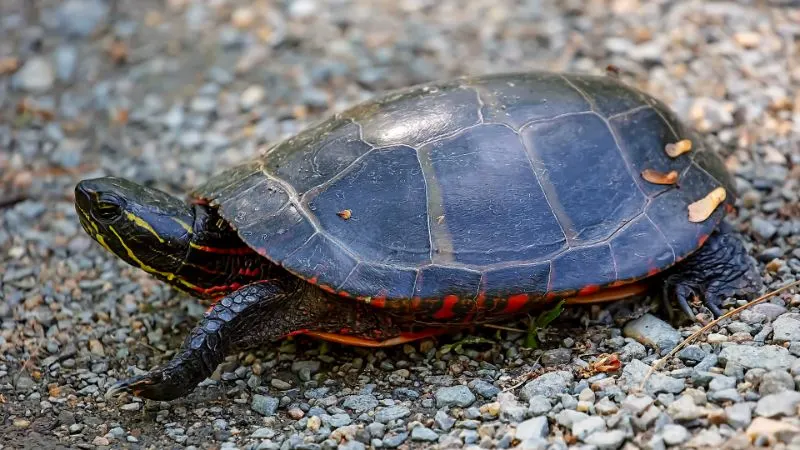
The Painted Turtle is the most widespread species of aquatic turtle in North America. Adorable in appearance, these tiny reptiles are fantastic contributors to the ecologies of the Western hemisphere.
The Painted Turtle is a water turtle of medium size that is distinguished by its dark upper shell and striking red markings on the lower shell and marginal carapace. There are yellow stripes on the head, neck, legs, and tail, and the skin tone ranges from black to olive. There is a wide variation in adult height, from about 2.5-10 inches. The juveniles look like the adults, except more vividly colored.
They are omnivores, eating anything from insects and small fish to plant life and even carrion if it’s available. A turtle’s food is typically a hodgepodge of whatever is available in its environment, but it is usually high in protein and fiber. The painted turtle is a skilled predator in the water and will snag anything small enough to eat.
The Painted Turtle spends the vast majority of its life in the water and only leaves to breed, disperse, or survive periods of drought. These reptiles can be found in every region of the Americas. They favor watery habitats where they won’t be swept away by swift currents, such as ponds, marshes, and slow-moving streams. The ideal water supply has a muddy bottom where the turtle can hide and is warm enough to keep the turtle’s body temperature stable.
See Related: What is a Critical Habitat? Everything You Need to Know
14. Chicken Turtle
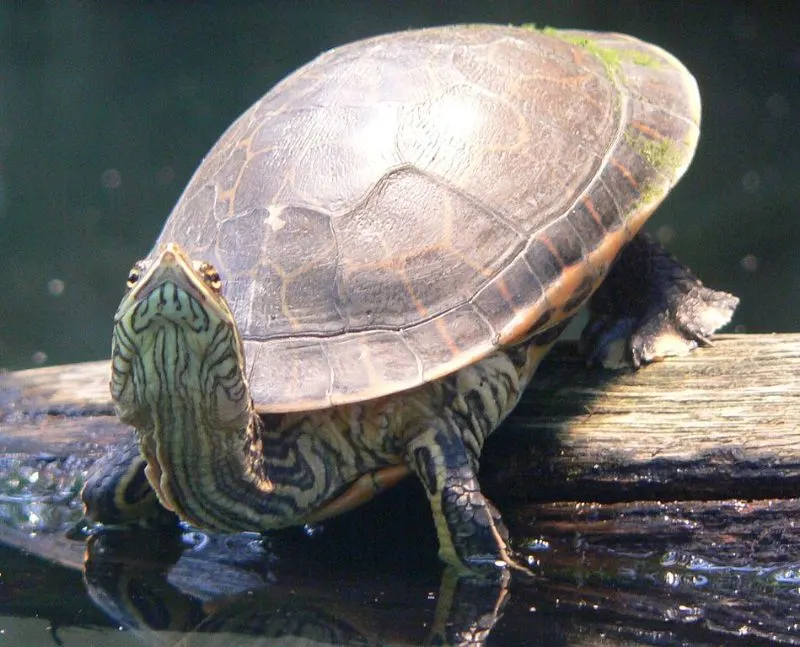
Chicken Turtles are medium-sized reptiles, having carapace that are 15-23 centimeters long. Their shells are widest over the hind legs, decorated with a pale yellowish netlike pattern.
This species is distinguished by its yellow-striped, exceptionally long neck and its black-and-yellow striped, vertically oriented “seat of its pants.”
Chicken Turtles do spend some time basking, but they spend most of their time swimming. Their preferred food is crayfish, but they also eat aquatic invertebrates, amphibian larvae, and other tiny fish and fish larvae. All males and some females of this species leave the wetland every winter to spend the cold season underground in the forest, making them one of the most terrestrial of our turtles.
The Coastal Plain of the southeastern United States is home to Chicken Turtles, while the Piedmont and Mountains are not. There are a number of different types of thickly vegetated aquatic environments in which this species can be found. Common habitats for Chicken Turtles are temporary or seasonal wetlands with plenty of vegetation and other types of shallow, calm water.
15. Yellow-Blotched Map Turtle or Yellow-Blotched Sawback
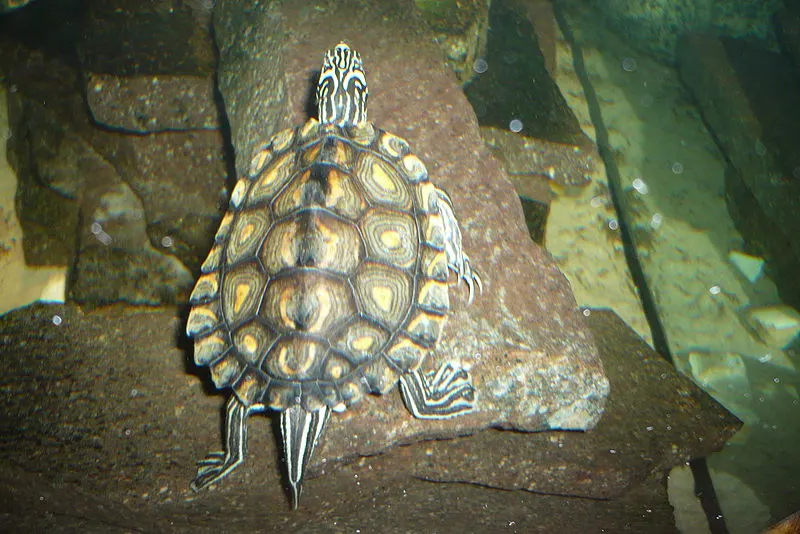
Yellow-Blotched Map Turtles range in size from medium to small. The adult length of a male carapace is between 9 and 11.5 centimeters. The average adult female is larger than an adult male, with a carapace length of 13-19 centimeters. When compared to other map turtles, the Yellow-Blotched kind has the longest and most prominent dorsal keel.
Although insects make up the bulk of their diet, Yellow-blotched Map Turtles also enjoy seafood, fresh vegetation, and crabs.
It can only be found in the Mississippi River basin, specifically in the Pascagoula River and its tributaries (a range it shares with the Pascagoula Map Turtle).
16. Ouachita Map Turtle
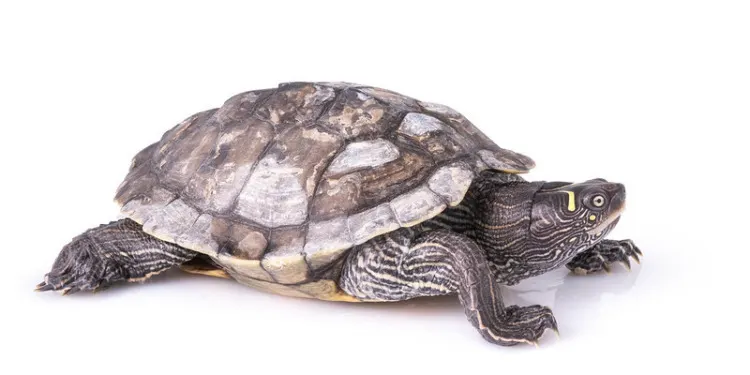
The upper shell of this small to medium-sized semiaquatic turtle features a noticeable ridge running down its length, and the head and limbs are marked with brilliant yellow lines. The upper shell is brown or olive, with yellow lines and circles that link to one another. There are sharp serrations around the back margin of the upper shell. The lower shell is a uniform golden color.
The body and head of the Ouachita Map Turtles are olive with numerous faint yellow lines. They have a huge yellow spot directly below each eye and a narrower yellow or orange-yellow marking that goes from behind each eye and up to the top of the skull.
The Ouachita Map Turtle eats aquatic plants, worms, insects, snails, crayfish, and dead fish. This turtle prefers ponds, slow-moving rivers, and reservoirs. Species of this kind can only be found in the United States. It can be found in the states of Louisiana, Mississippi, Texas, Alabama, Oklahoma, Arkansas, Kansas, Minnesota, Missouri, Iowa, Indiana, Wisconsin, Ohio, Illinois, Tennessee, West Virginia, and Kentucky.
17. Northern Map Turtle
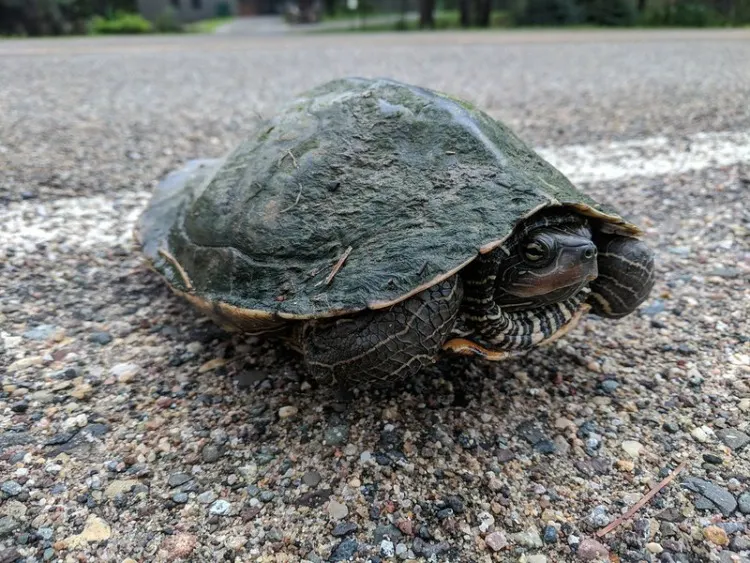
The northern map turtle is a species of aquatic turtle with carapace that typically grows to be about 15 centimeters long. The upper shell’s backside is heavily serrated . The top of the shell is often a dark shade of brown or olive, and it features a delicate, wavy golden pattern that resembles a road map. The bottom shell) is a pale yellow, and the scute (shell scale) joints are a dark brown.
There are many thin, greenish-yellow streaks throughout the dark brown to nearly black body and appendages. Behind each eye is a tiny, yellow spot that often projects in a neckward direction.
Adult male northern map turtles eat aquatic insects, notably caddisfly and mayfly larvae, whereas females eat mostly plants. The adult females, who are much larger than the juveniles, feed on crayfish, snails, and other freshwater mollusks, as well as some insect larvae. The females may crush their victims, remove the exoskeletons or shells, and devour their bodies because of the size of their heads.
They are most common in waterways of moderate size, such as ponds, reservoirs, sloughs, and small rivers. In addition to a rocky or gravelly substrate and enough of plants for sunbathing, these fish need plenty of places to hide out.
See Related: Most Polluted Rivers in the United States
18. False Map Turtle
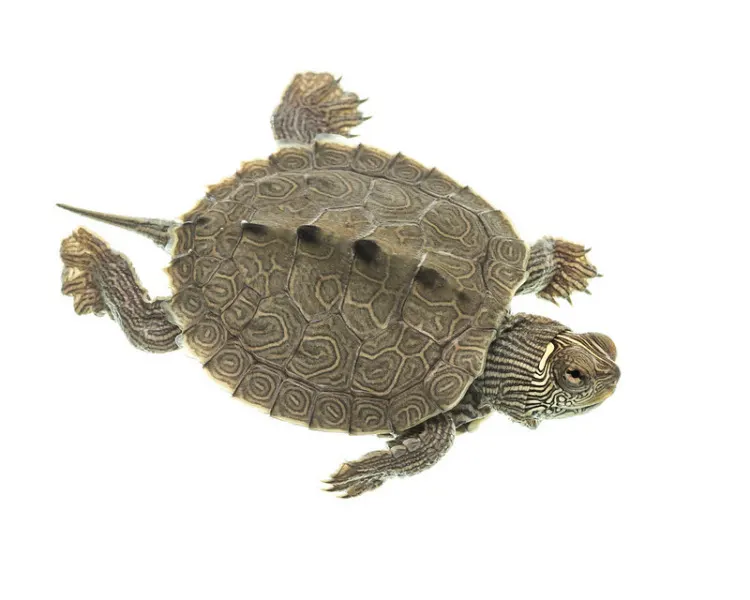
The carapace of the False Map Turtle is characterized by a row of low spines along the vertebral column and a serrated posterior rim. Carapace coloration ranges from olive to brown, with light yellowish patterns and dark edging.
The False Map Turtle has a dark gray or brown back and light brown, yellow, or white stripes. The eye is crossed by a black bar and might be brown, pale yellow, white, or green. The head and neck’s dorsal lines merge with the narrow, hooked marks behind the eyes. Tiny white patches can also be found on the cheeks and chin.
Morning is when they eat. A False Map Turtle’s diet may include anything from snails and crayfish to aquatic bug larvae, dead fish, and even aquatic vegetation.
The False Map Turtle can be found in the Missouri and Mississippi River systems’ major streams throughout its range, which stretches from Ohio, Indiana, Illinois, Wisconsin, and Minnesota to Alabama, Mississippi, and Louisiana.
19. Mississippi Map Turtle
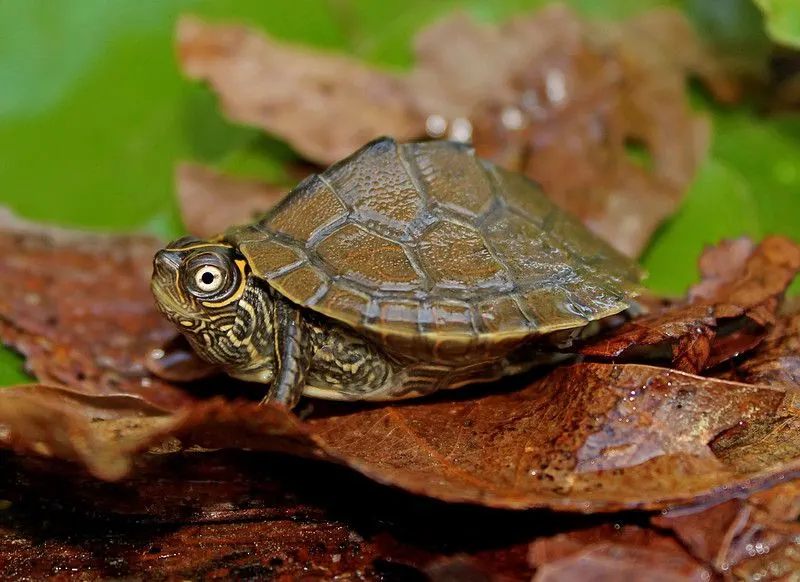
When fully grown, the Mississippi Map Turtle is a medium-sized aquatic turtle. The average length of an adult female carapace is 15-25 centimeters. Meanwhile, males can attain a carapace length of 9-13 centimeters.
The upper shell of the Mississippi Map Turtle is characterized by a ridge that runs along the vertebral region and is serrated along the back edge. The shell has a brown or olive tint with thin, yellow lines or circles. The plastron is a pale greenish yellow with thin brown lines along the scutes’ seams.
Their bright yellow reverse crescents, which sweep under and behind their eyes set them apart from other map species. This arced line may be seen atop the turtle’s head, running down the middle and branching off to the sides.
The typical lifespan of a Mississippi Map Turtle is between 15 and 20 years, but a captive turtle may live 30 years or more. Like aquatic turtles, Mississippi maps can swim, eat, and do just about everything else. Indeed, Mississippi maps only eat when submerged in water.
These turtles are omnivores, however, adults have a higher carnivory than most other “slider” turtles, making it simple to overfeed them. Map turtles named after the Mississippi River are native to that river’s delta. Their original habitat is in the Midwest, specifically in Illinois and Iowa, and it extends south into Mississippi and Texas. Nebraska and a few other states along the Mississippi River’s tributaries also have them.
See Related: Fastest Animals in the World
Snapping Turtles
20. Common Snapping Turtle
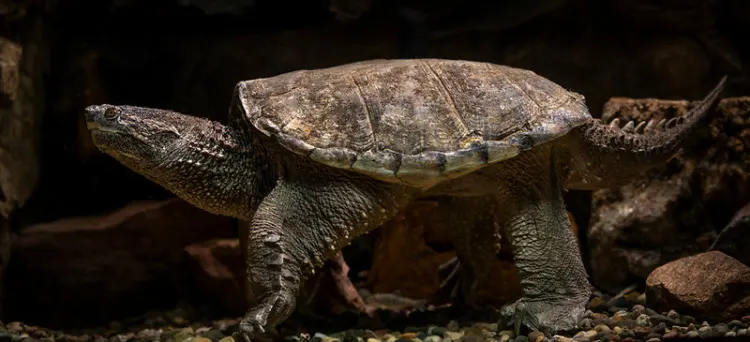
One of the largest freshwater turtles is the Common Snapping Turtle. The extremely active head and neck of this species has earned it a reputation for aggressive behavior when the animal is out of the water.
The carapace of these turtles is ridged, lending them a tough appearance; however, the ridges are typically more evident on juveniles. The carapace can be either black or a light brown tint. The males of this species typically grow to be considerably larger than their female counterparts.
The Common Snapping Turtle feeds on both plants and animals. They play an essential role as water scavengers due to their dual diet of plant and animal debris. They are aggressive predators that eat just about anything, from insects to fish to frogs to small reptiles to unsuspecting birds to tiny mammals.
Common Snapping Turtles can be found in their natural habitats as far east as Nova Scotia and Florida, and as far west as the edge of the Rocky Mountains in southeastern Canada. These reptiles are typically found in water, whether it be a river, lake, marsh, pond, or stream. They could also exist in brackish areas like estuaries.
21. Alligator Snapping Turtle
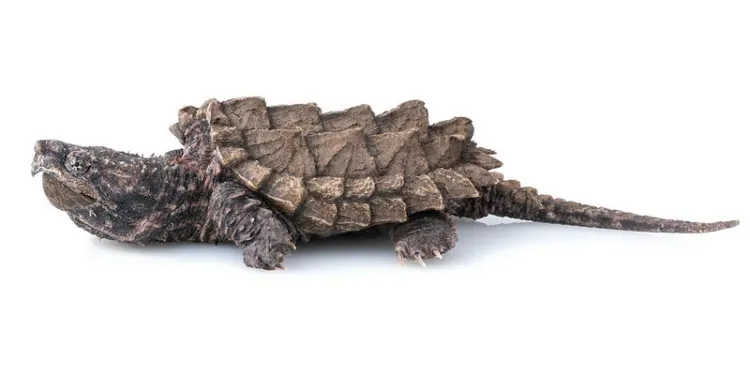
As one of the heaviest freshwater turtles, the Alligator Snapping Turtle commands attention. It gets its common name from the resemblance between the ridges on its shell and the rough, ridged skin of an alligator, and from the fact that this turtle has extremely powerful jaws.
The tall, thick shell of the Alligator Snapping Turtle is covered in three ridges of enormous scales (osteoderms), giving it a prehistoric appearance reminiscent of the plated dinosaurs. The turtles are typically covered with algae and can appear a uniform gray, brown, black, or olive green.
The turtle’s camouflage is helped along by the radial yellow stripes that surround its eyes. A star-shaped array of fleshy, filamentous “eyelashes” frames each of their eyes.
The diet of an Alligator Snapping Turtle is composed almost exclusively of carrion. Fish, fish parts, mollusks, dead animals, and amphibians make up the bulk of their natural diet. In addition to other turtles, snakes, crayfish, worms, water birds, aquatic vegetation, and even alligators are among their favorite foods.
The seas of the southeastern United States are home to the greatest concentrations of Alligator Snapping Turtles. They can be found in the southeast corner of Kansas, Missouri, eastern Iowa, western Illinois, southern Indiana, western Kentucky, and western Tennessee, as well as the eastern corner of Kansas and the Florida Panhandle to the west.
They can be seen in the Gavins Point Dam Aquarium in Yankton, South Dakota, which is located at the Missouri River’s southernmost dam at Gavins Point. There are Alligator Snapping Turtles in the waterways.
Mud Turtles and Musk Turtles
22. Eastern Mud Turtle
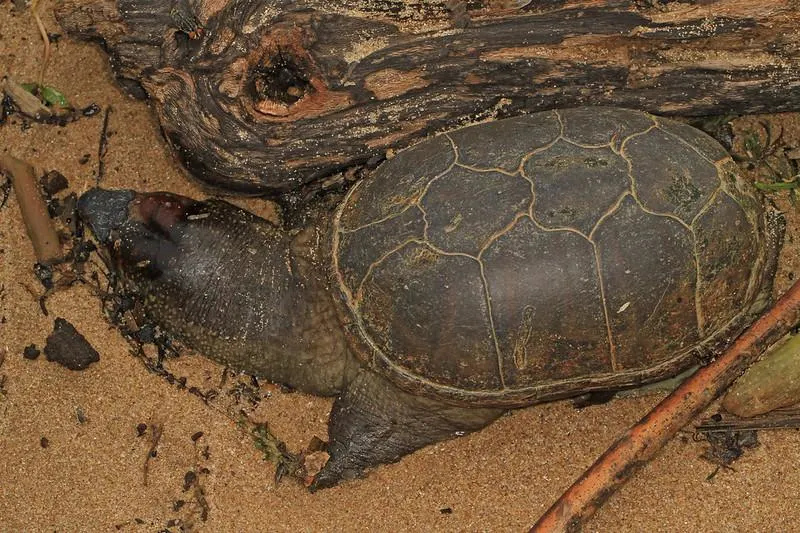
The Eastern Mud Turtle is a small, elusive reptile that can be difficult to spot. The length of its carapace is between 3 and 4 inches (7.6 and 10.2 cm). The carapace is keels-less, has no discernible pattern, and can be anywhere from yellow to black in hue.
The plastron is big and double-hinged; it ranges in color from yellow to brown and may occasionally feature a black pattern. The legs and tail are also gray, but the chin and throat are yellowish-grey with brown streaks and mottling. The iris of an eastern mud turtle is yellow and clouded with brown pigment, and the animal has webbed feet.
The Eastern Mud Turtle is a true omnivore, eating anything from watery plants to insects to carrion to frogs to crayfish. Eastern mud turtles, especially the smaller ones, eat on water invertebrates, algae, and carrion.
The United States is the only known home to this species. Virginia, Tennessee, Pennsylvania, North Carolina, New York, and Missouri all have sizable populations, however, they are found all across the United States.
See Related: Ways to Conserve Natural Resources
23. Striped Mud Turtle
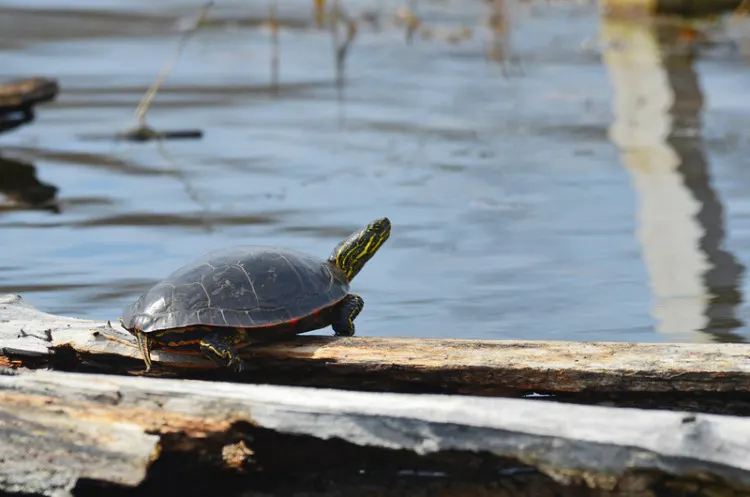
The Striped Mud Turtle is an aquatic reptile with a tiny, oval shell that can grow to a maximum of 10 centimeters. The carapace of this species is brown with three faint stripes, while the plastron, or lower shell, is a rusty tint. The big heads of striped mud turtles are distinguished by two narrow yellow stripes on either side.
This Striped Mud Turtle eats anything it can get its shell on. Its diet consists of a wide variety of animals and plants, including bugs, snails, fish, dead animals, algae, and plants. Dried krill is another food source for the striped mud turtle.
Blackwater marshes and rivers, permanent ponds and small lakes, ditches, and temporary ponds are the primary habitats of the Striped Mud Turtle. We find the striped mud turtle in the states of Florida, Georgia, North Carolina, South Carolina, and Virginia.
24. Common Musk Turtle or Eastern Musk Turtle
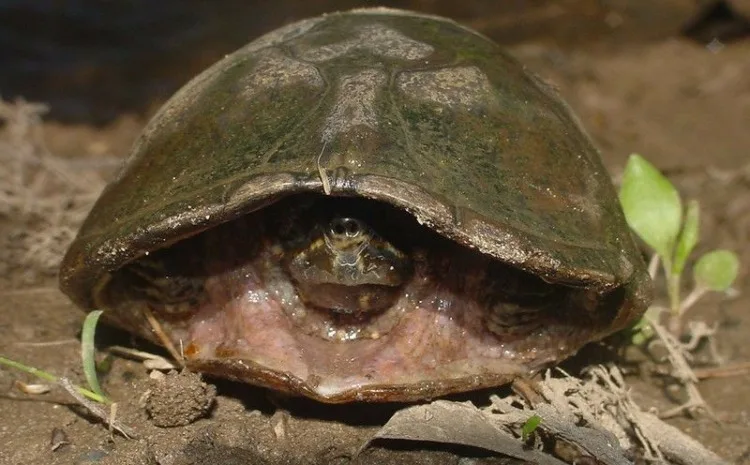
A little turtle found only in North America, the Common Musk Turtle is nonetheless a fascinating species. It has a long neck and very small legs and can be any shade of black, grey, or brown. The yellow lines on the turtle’s neck serve as a useful field marker and are often visible even in swimming turtles when viewed from above.
The heads of these turtles have a hazy triangular shape, and they have a pointed snout, a sharp beak, and yellow-green stripes running from the tip of the nose to the base of the neck. The chin and the throat both have barbels. Their ability to breathe underwater is made possible by papillae that look like little buds on their tiny tongues.
A Common Musk Turtle’s diet consists primarily of carrion and waste. They eat all sorts of aquatic invertebrates, such as crayfish, freshwater clams, snails, aquatic larvae, and insects. Animals such as fish, tadpoles, and carrion are also consumed.
They prefer slow-moving, muddy water in shallow waterways, but they can be found in a wide range of wetland and littoral zones. Swamps, marshes, temporary pools, and even big rivers and lakes all fall under this category. You can find them in Southern Ontario, southern Quebec, and the eastern United States.
Pond and River Turtles of Eurasia
25. Spotted Turtle or Black Pond Turtle
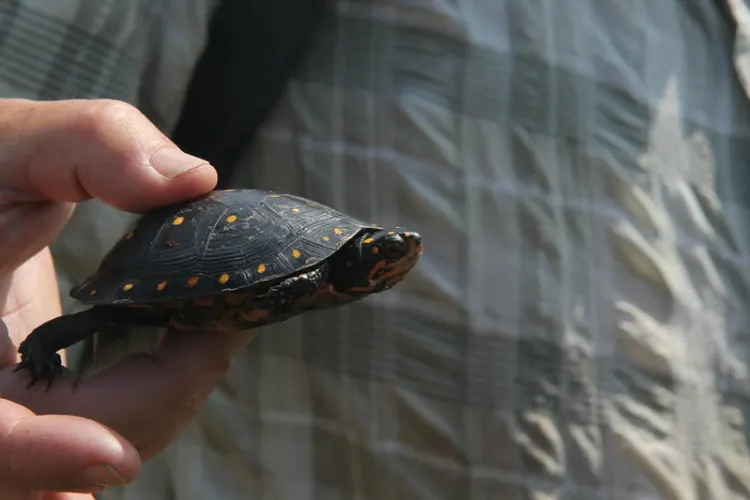
Black in color with a few yellowish patches, this turtle is also known as the Spotted Pond Turtle or Black Pond Turtle. Its carapace is extremely domed, and its three keels are interrupted. In terms of the plastron, it is big, angular laterally, and truncate anteriorly.
The size of the head is relatively enormous. The muzzle does not protrude and is instead quite short. The tail is vanishingly brief. The hard shell is a dark brown or black color, and it is elegantly marked with yellow spots and radiating streaks. The soft portions are also a dark brown or black color and are marked with round yellow spots, the largest of which are found on the head and neck.
The Spotted Pond Turtle is predominantly a carnivore, feeding on aquatic invertebrates. They break down the shells of snails, prawns, crabs, and other crustaceans using the bony surfaces of their powerful jaws. They also consume grasses, mollusks, fish, amphibians, and cereal grains.
Northern India, specifically the river drainages of the Indus and Ganges, is home to spotted pond turtles. Geographically, they can be found in the southern portion of Pakistan, northern India, Bangladesh, and the eastern portion of Nepal. They have a partial aquatic lifestyle and like wetlands, ponds, and oxbow lakes.
See Related: Do Lions Eat Elephants? Here’s What to Know
26. Chinese Pond Turtle
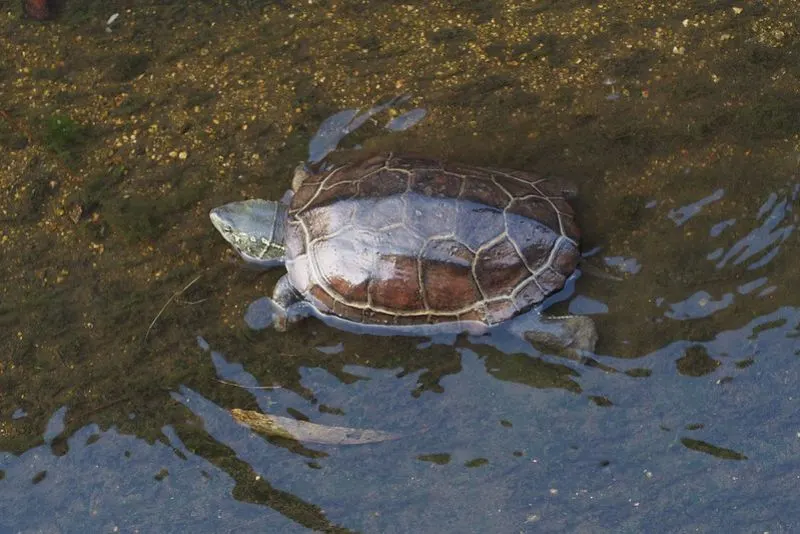
A member of one of the most numerous and species-rich turtle families, the Chinese pond turtle can be found in warm water habitats worldwide. All turtles in this family are commonly known as Leaf Turtles.
Their necks are typically drawn back in a vertical position, and they have webbed toes. There are 24 scutes around the edges of their carapaces. There are 12 scutes that make up the plastron, but no mesoplastron. The pectoral and abdominal scutes are in touch with the marginal scutes.
Chinese Pond Turtle are able to thrive in both aquatic and terrestrial environments. Chinese Pond Turtle are omnivores, meaning they consume both plant matter and animal matter, such as worms, snails, insects, and fish.
The natural range of the Chinese Pond Turtle includes China and Korea. They prefer muddy or sandy environments, so you’ll find them in marshes, shallow ponds, streams, and canals.
27. Chinese Box Turtle, Yellow-Margined Box Turtle, or Snake-Eating Turtle
Due to excessive harvesting for human consumption and importation for the pet trade, the Chinese Box Turtle, a semiaquatic species, is at risk of extinction in its native China.
The shell and plastron of a Chinese box turtle are a dark brown color, and they have a cream or yellow stripe running down the middle of their shell. The sides of the turtle and around the borders of the plastron are softly tinted, usually cream or yellow.
These reptiles have a large dome on their shell and five claws on each front foot and four claws on each back foot. The limbs of the turtle are dark brown in hue while its head is golden brown.
The Chinese Box Turtle is omnivorous meaning that it eats a diet that includes both vegetables and meat. Chinese Box Turtles are, as their name suggests, a type of Box Turtle found naturally in China, Taiwan, and Japan.
28. Japanese Pond Turtle
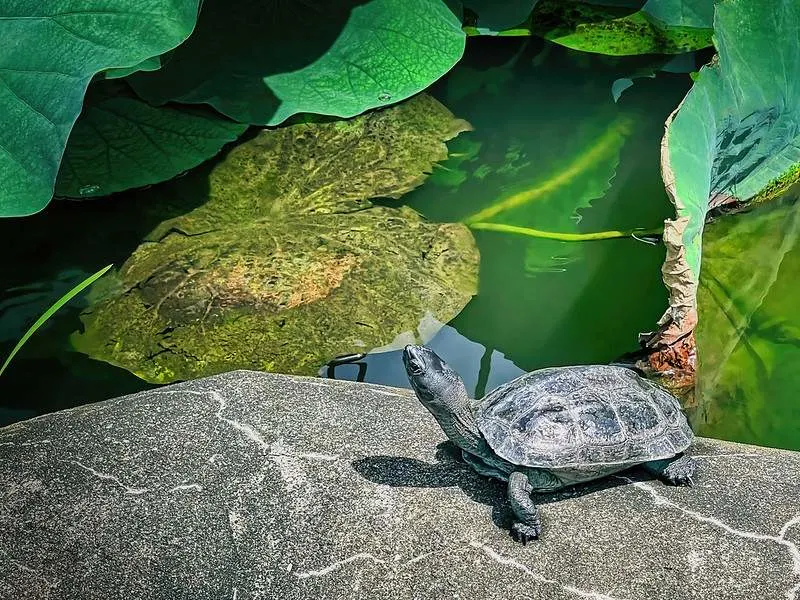
The maximum size for a female Japanese Pond Turtle is around 18 centimeters, but males rarely grow any longer than 14 centimeters.
Their shells are a shade between yellow and brown, although can occasionally look darker. The shell features a ridge that runs down its middle. These turtles have olive shells with bright orange stripes along either side.
The diet of a Japanese pond turtle varies widely. Foods high in animal protein and veggies make up the bulk of their diet. Fish, frogs, crabs, insects, and worms are some of the Japanese Pond Turtle’s preferred foods. As far as we know, this species can only be found in Japan.
Types of Pet Turtles
29. Red-Eared Sliders
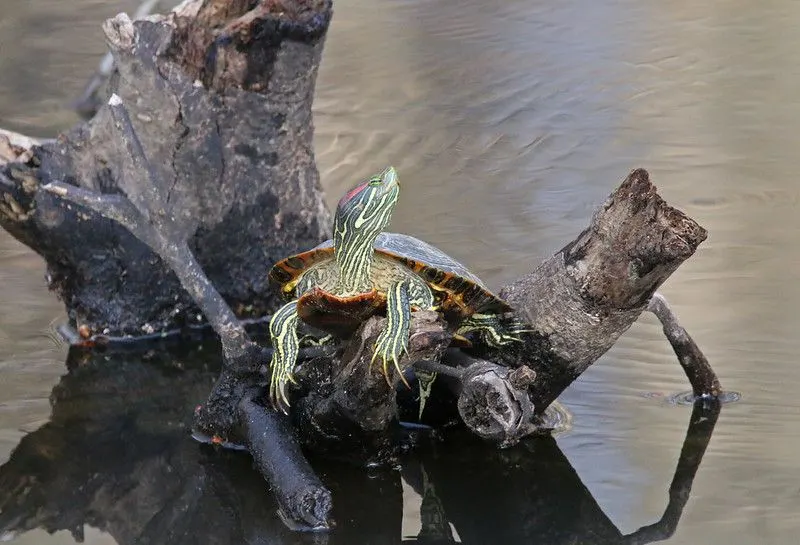
If you are looking for a pet turtle, the red-eared slider tops the list of the most popular species. They are more sociable and easier to bond with, compared to most of their relatives.
Also, they are quite active and easy to find. Red-eared sliders are among the turtles that stay small forever and are best suited for indoor aquariums – although you can still rear them outdoors. However, you must ensure you get them the right shelter, cleaned, and with warm temperatures.
This semiaquatic turtle is among the most popular turtle species in the US and the rest of the world. Red-eared sliders can grow up to 16 inches, although the average size is around 8 inches.
The turtle can live up to 40 years with the right conditions, although this tends to be shorter when the turtle is domesticated.
See related: Great Hammerhead Shark
30. African Sideneck Turtles
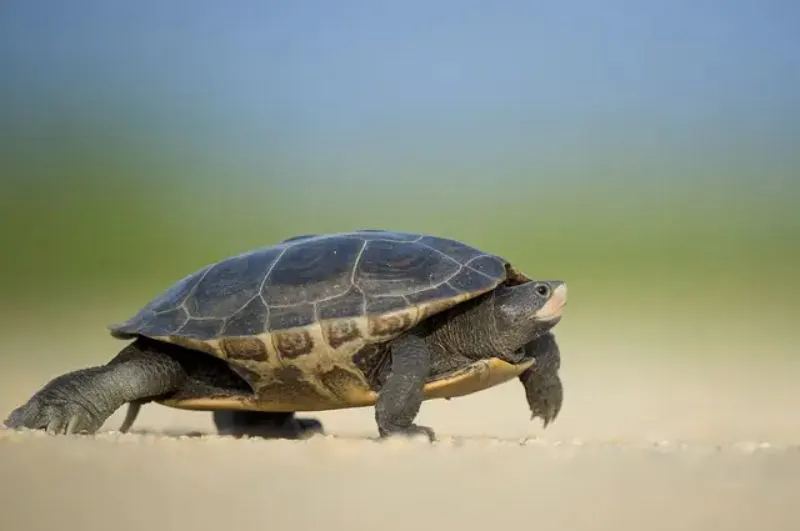
These are small freshwater turtles that have their roots in sub-Saharan Africa. This turtle species gets its name from its distinct long neck, which usually can’t retract fully from the shell.
For this reason, they try to draw the neck to the side, folding it under the upper edge of the shell, hence the name.
They are rounded in shape and can grow up to 17.7 inches. This makes them an incredible choice for a pet turtle. However, you should note that they are a bit more complex to care for than many other turtle types.
For instance, you need to always keep the water clean. This can be achieved by getting the right filtration system, which will prevent frequent water changes.
They also require a large tank, as they are adept swimmers. Enough UV lights will also help to give them the right temperatures to busk under (always over 70 degrees).
See Related: Animals That Start with the Letter M
31. Western Painted Turtles

When it comes to looks, the Western Painted Turtle certainly carries the day. They have a distinctive look, with detailed shell patterns and markings.
They are small, beautiful, and can fit either as indoor or outdoor pets. However, since they also like to swim, they will also require a large tank. Their home should also be warm and clean.
These types of turtles are native to North America, but you’ll also find them in Canada and Northern Mexico. Female western-painted turtles grow up to 10 inches, while the males only grow up to 6 inches.
These turtles are shy, love cuddling, and eat while swimming.
What is a Turtle?
Before we even dive deeper into the different types of turtles, it is important first to understand this animal. A turtle is a type of reptile belonging to the kingdom Animalia, class Reptilia, and order Testudines. A turtle has over 13 families with different genera and species names.
This animal came into existence over 200 million years ago and evolved before other reptiles such as crocodiles and snakes. And, although the name turtle can include tortoise, the two animals differ significantly.
Turtles are water dwellers while tortoises live on land. Also, while both animals have their body encased in a bony shell, these turtle shells differ in texture and design.
Each of the turtle shells has a unique architecture that enables it to adapt to its habitat. For instance, when you look at their legs, you find that the tortoise has elephant-like feet. Turtles on their part have flipper-like feet that enable them to swim.
FAQ
What are the 7 turtles?
There is no such thing as “7 types of turtles.” There are many types of turtles, there’s no strict number. For example, sea turtles include the green sea turtle, the hawksbill sea turtle, and the leatherback sea turtle.
What are 5 turtle species?
The five types of turtles are the leatherback turtle, loggerhead turtle, green turtle, ridley sea turtle, and hawksbill sea turtle.
What is the most common turtle type?
The type of turtle most often found in the pet trade is the aquatic turtle. But types of turtles also include Red-Eared Sliders, Mosquito Turtles, Painted Turtles, Black Swamp Turtles, and the Alligator Snapper.
Can You Take a Turtle as a Pet?
Turtles are superb animals and amazing to watch. For this reason, you might think of creating a local habitat and raising some turtles.

